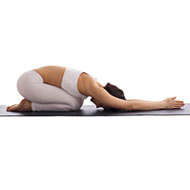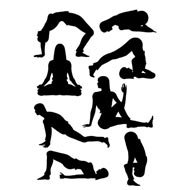- Raja yoga
- Yoga Stretches
- Jivamukti Yoga Poses
- Yoga Tree Pose
- Sun and Moon Yoga
- Wind Removing Pose
- Hare Pose
- Accomplished Pose
- Urdhva Mukha Pinch Mayurasana
- Revolved Abdomen Pose
- Raised Foot Pose
- Scorpion Pose
- Butterfly Pose
- Revolved Twist
- Balancing Stick Pose
- Cat Pose
- Supported Shoulderstand
- Crane Pose
- Handstand
- Happy Baby Pose
- Firefly Pose
- Scale Pose
- Side Plank Pose
- Upward Facing Two-Foot Staff Pose
- Reclining Big Toe Pose
- Stick Pose
- Revolved Head-to-Knee Pose
- Full Boat Pose
- Upward Extended Feet Pose
- Yoga arm balance poses
- Core Yoga
- Inversion Yoga Poses
- Seated And Twist Yoga
- Horse Pose
- Cobbler Pose
- Seated Wide Angle Pose
- The Compass Pose
- Half Crow Pose
- Bound Half Moon Pose
- Lotus Pose
- Reverse Warrior Pose
- Fixed Firm Pose
- Back-bend Poses
- Forward bend Poses
- Sarvangasana
- Ashtanga Yoga Poses
- Warm up poses
- Seated Poses
- Seated Forward Bends
- Chair Poses
- Standing Poses
- Standing Balancing poses
- Yoga Asanas
- Hatha Yoga Asanas
- Yoga Postures Online
- Partner Yoga Poses
- Anusara Yoga Poses
- Advanced Yoga poses
- Restorative Yoga Poses
- Kids Yoga Poses
- Beginning Yoga Postures
Half Tortoise Pose - Ardha Kurmasana
The Ardha-Kurmasana or Half-Tortoise Pose is a relaxing pose that also offers an invigorating stretch to your back.
This posture is part of the series of 26 asanas that form a part of Bikram Yoga.The pose is usually performed towards the end of a yoga session in order to stretch the body and allow the heart rate to come back to normal.
It can also be used towards the start of your workout in order to make your body more limber so that the muscles can cope with the demands placed on them by yoga.
Steps :
- Sit down on a yoga mat in the Vajra Asana or Diamond Pose with your buttocks resting on your heels.
- Inhale and lift both your arms to the sky. Bring the palms of your hands together and intertwine your two thumbs together. Your arms should be straight with your biceps touching your ears. Straighten your back and feel the stretch.
- Exhale and slowly pivot down from your waist until your little fingers and forehead touch the yoga mat.
- Hold this pose for at least 20 seconds while you continue to breathe normally.
- Inhale and come back to the starting position with your hands straight up in the sky above your head.
- Exhale, release your arms, and come back to the Vajra Asana.
Precautions :
- If you are new to the practice of yoga, it is best to first learn how to properly perform the posture under the guidance of a trained instructor.
- You should also consult a doctor if you are pregnant or suffer from any pre-existing medical conditions, before taking up any new form of exercise.
- Do not try to perform this pose after a heavy meal or under the influence of alcohol or drugs.
- If you are performing this pose as a part of a Bikram Yoga class, do ensure that you are properly hydrated prior to starting your class.
Beginner’s Tip :
If you find it difficult to perform this posture, try starting out with the similar, but slightly simpler Bala Asana or Child Pose.
Benefit to Body Part :
- This posture results in a rush of blood to the brain cells. This improves brain function by ensuring that the brain cells receive sufficient nutrition. With regular practice, this exercise is also said to activate the dormant cells in the brain.
- In addition, regular practice of this posture slows down the normal degradation of brain cells and can thus helps to slow down the process of ageing.
- The Half Tortoise Pose also helps to tone the abdominal area and the thighs.
- It provides a deep relaxing stretch to the spine.
- It also provides a deep stretch to the shoulder muscles.
- This posture also improves the flexibility of the hips.
Therapeutic Applications :
- Performing this posture on a regular basis helps to balance the levels of serotonin and melatonin in the brain. As these two chemicals are responsible for controlling the body’s sleep cycle, regular practice of the Ardha-Kurmasana can help deal with sleeping disorders.
- This posture also massages and stretches the lungs and can be helpful for people suffering from respiratory disorders such as asthma.
- The Half Tortoise is also an excellent posture for ailments of the digestive system and can help counter Irritable Bowel Syndrome and its associated symptoms such as flatulence, constipation, and diarrhea.
- It is also an excellent exercise for those suffering from migraines.
- The posture is also helpful for diabetics as it helps control blood sugar levels.
- The Ardha-Kurmasana is also very good for stress relief.
Variations :
- As mentioned earlier, beginners who are not comfortable performing the Ardha-Kurmasana, should start out by performing the Bala Asana (Child Pose) instead. The steps for performing the Child Pose are similar to those for the Half Tortoise Pose, however, the hands, instead of being stretched out in front of the body, are kept in a relaxed posture at the back.
- To further increase the stretch, work on straightening the arms so that your wrists, elbows and triceps forma perfect straight line and you experience some amount of stress on your shoulder blades.
- You should also concentrate on ensuring that your heels and buttocks remain in contact at all times as this again increases the intensity of the stretch.
- Keep your mid-section taut throughout the pose as this will make it easier for you to keep your heels and buttocks in contact at all times.
- Resist the urge to draw your chin into your chest when you are performing the stretch. Try to keep your chin as away from your chest as possible while maintaining contact between the forehead and the yoga mat.
Preparatory Poses :
The Ardha-Kurmasana is started by sitting in the Vajra Asana or the Diamond Pose. This is similar to the traditional Japanese method of sitting where you sit by resting your buttocks upon your heels with your knees and feet as close together as possible.
Follow Up Poses :
If you are performing the Ardha-Kurmasana towards the end of your yoga routine, one of the best follow up poses is the Shava Asana or Corpse Pose. This pose further amplifies the relaxation benefits offered by the Half Tortoise Pose as it allows your mind to relax and re-charge and enables your body to fully recover from the rigors of your work and your workout.



